Related Research Articles

The Geheime Staatspolizei, abbreviated Gestapo, was the official secret police of Nazi Germany and in German-occupied Europe.

Reinhard Tristan Eugen Heydrich was a high-ranking German SS and police official during the Nazi era and a principal architect of the Holocaust. He was chief of the Reich Security Main Office. He was also Stellvertretender Reichsprotektor of Bohemia and Moravia. He served as president of the International Criminal Police Commission and chaired the January 1942 Wannsee Conference which formalised plans for the "Final Solution to the Jewish Question"—the deportation and genocide of all Jews in German-occupied Europe.
Sicherheitsdienst, full title Sicherheitsdienst des Reichsführers-SS, or SD, was the intelligence agency of the SS and the Nazi Party in Nazi Germany. Originating in 1931, the organization was the first Nazi intelligence organization to be established and was considered a sister organization with the Gestapo through integration of SS members and operational procedures. The SD was administered as an independent SS office between 1933 and 1939. That year the SD was transferred over to the Reich Security Main Office, as one of its seven departments. Its first director, Reinhard Heydrich, intended for the SD to bring every single individual within the Third Reich's reach under "continuous supervision".
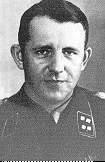
Rudolf Lange was a German SS functionary and police official during the Nazi era. With the invasion of the Soviet Union, he served in Einsatzgruppe A before becoming a commander in the Sicherheitsdienst (SD) and all RSHA personnel in Riga, Latvia. He attended the Wannsee Conference, and was largely responsible for implementing the murder of Latvia's Jewish population during the Holocaust.

The Reich Security Main Office was an organization subordinate to Heinrich Himmler in his dual capacity as Chef der Deutschen Polizei and Reichsführer-SS, the head of the Nazi Party's Schutzstaffel (SS). The organization's stated duty was to fight all "enemies of the Reich" inside and outside the borders of Nazi Germany.

Gerhard Friedrich Ernst Flesch was a German SS functionary during the Nazi era. Post World War II, he was tried, found guilty and executed for his crimes, specifically the torture and murder of members of the Norwegian resistance movement.

Arthur Nebe was a key functionary in the security and police apparatus of Nazi Germany and from 1941, a major perpetrator of the Holocaust.

Bruno Streckenbach was a German SS functionary during the Nazi era. He was the head of Administration and Personnel Department of the Reich Security Main Office (RSHA). Streckenbach was responsible for many thousands of murders committed by Nazi mobile killing squads known as Einsatzgruppen.
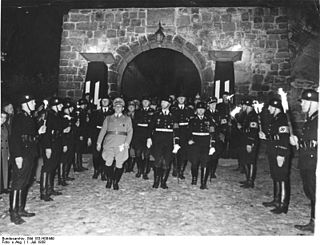
The Allgemeine SS was a major branch of the Schutzstaffel (SS) paramilitary forces of Nazi Germany; it was managed by the SS Main Office (SS-Hauptamt). The Allgemeine SS was officially established in the autumn of 1934 to distinguish its members from the SS-Verfügungstruppe, which later became the Waffen-SS, and the SS-Totenkopfverbände, which were in charge of the Nazi concentration camps and extermination camps. SS formations committed many war crimes against civilians and allied servicemen.

The Ordnungspolizei, abbreviated Orpo, meaning "Order Police", were the uniformed police force in Nazi Germany from 1936 to 1945. The Orpo organisation was absorbed into the Nazi monopoly on power after regional police jurisdiction was removed in favour of the central Nazi government. The Orpo was controlled, nominally by the Interior Ministry but its executive functions rested with the leadership of the SS until the end of World War II. Owing to their green uniforms, Orpo were also referred to as Grüne Polizei. The force was first established as a centralised organisation uniting the municipal, city, and rural uniformed police that had been organised on a state-by-state basis.

Kriminalpolizei is the standard term for the criminal investigation agency within the police forces of Germany, Austria and the German-speaking cantons of Switzerland. In Nazi Germany, the Kripo was the criminal police department for the entire Reich. Today, in the Federal Republic of Germany, the state police (Landespolizei) perform the majority of investigations. Its Criminal Investigation Department is known as the Kriminalpolizei or more colloquially, the Kripo.
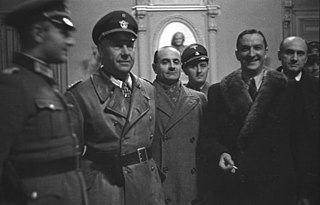
The Sicherheitspolizei, often abbreviated as SiPo, was a term used in Germany for security police. In the Nazi era, it referred to the state political and criminal investigation security agencies. It was made up by the combined forces of the Gestapo and the Kriminalpolizei between 1936 and 1939. As a formal agency, the SiPo was incorporated into the Reich Security Main Office (RSHA) in 1939, but the term continued to be used informally until the end of World War II in Europe.
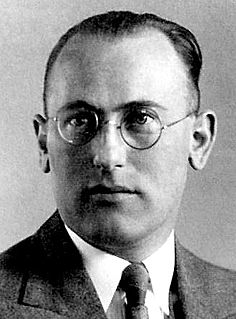
Franz Walter Stahlecker was commander of the SS security forces for the Reichskommissariat Ostland in 1941–42. Stahlecker commanded Einsatzgruppe A, the most murderous of the four Einsatzgruppen active in German-occupied Eastern Europe. He was fatally wounded in action by Soviet partisans and was replaced by Heinz Jost.
There were three main police forces in Nazi Germany under the Reichsführer-SS, Heinrich Himmler from 1936:
Hauptamt Sicherheitspolizei was a central state police agency command office in Nazi Germany entrusted with overseeing the Kriminalpolizei and the Geheime Staatspolizei for the years 1936–1939.
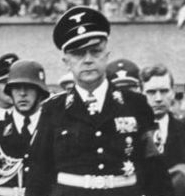
Friedrich Karl Freiherr von Eberstein was a member of the German nobility, early member of the Nazi Party, the SA, and the SS. He was elected to the Reichstag and held the position of the chief of the Munich Police during the Nazi era. Eberstein was a witness at the Nuremberg Trials.
Units and commands of the Schutzstaffel were organizational titles used by the SS to describe the many groups, forces, and formations that existed within the SS from its inception in 1923 to the eventual fall of Nazi Germany in 1945.

Friedrich Panzinger was a German SS officer during the Nazi era. He served as the head of the Reich Security Main Office (RSHA) Amt IV A, from September 1943 to May 1944 and the commanding officer of three sub-group Einsatzkommando of Einsatzgruppen A in the Baltic States and Belarus. From 15 August 1944 forward, he was chief of RSHA Amt V, the Kriminalpolizei. After the war, Panzinger was arrested in 1946 and imprisoned by the Soviet Union for being a war criminal. Released in 1955, he was a member of the Bundesnachrichtendienst. In 1959, Panzinger committed suicide in his jail cell after being arrested for war crimes.

Adolf Hitler, the dictator of Nazi Germany, initiated World War II in Europe with the invasion of Poland in September 1939 and was central to the Holocaust. He was hated by his persecuted enemies and even by some of his own countrymen. Although attempts were made to assassinate him, none were successful. Hitler had numerous bodyguard units over the years which provided security.
Kriminalpolizei, often abbreviated as Kripo, is the German name for a criminal investigation department. This article deals with the agency during the Nazi era.
References
Citations
- 1 2 3 4 Martin Eberhard (1999), Die Kriminalpolizei 1933-1939 (Universität Konstanz, Philosophische Fakultät 2013-12-15.
- ↑ Williams 2001, p. 77.
- ↑ Williams 2001, pp. 61, 77.
- ↑ Weale 2010, pp. 134, 135.
- 1 2 Friedlander 1995, p. 55.
- ↑ Weale 2012, pp. 140–144.
Bibliography
- Friedlander, Henry (1995). The Origins of Nazi Genocide: From Euthanasia to the Final Solution. Chapel Hill: University of North Carolina Press. ISBN 978-0807822081.
- Weale, Adrian (2010). The SS: A New History. London: Little, Brown. ISBN 978-1408703045.
- Weale, Adrian (2012). Army of Evil: A History of the SS. New York: Caliber Printing. ISBN 978-0-451-23791-0.
- Williams, Max (2001). Reinhard Heydrich: The Biography, Volume 1—Road To War. Church Stretton: Ulric Publishing. ISBN 978-0-9537577-5-6.